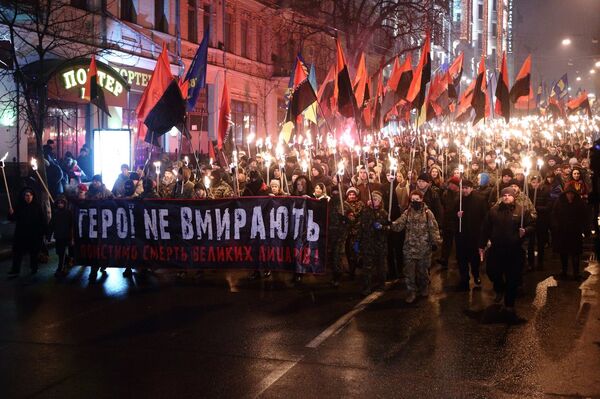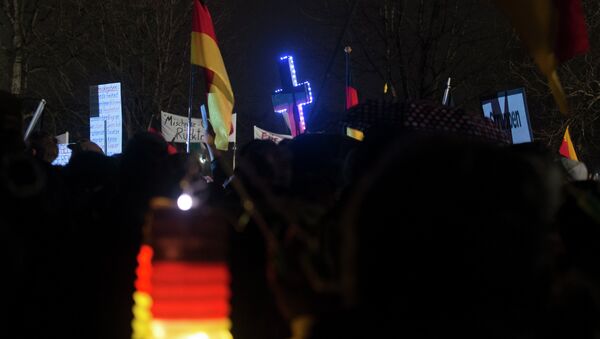The latest PEGIDA rally in Dresden — held under slogans such as "Against religious fanaticism and every kind of radicalism" — was joined by an estimated 18 000 people. The gathering was dwarfed by massive counter-demonstrations in Dresden, Berlin and in Cologne that spoke in support of immigrants and condemned intolerance. The famous Cologne cathedral and Berlin's Brandenburg gate have switched off lighting as a sign of protest against xenophobic rallies.
The PEGIDA movement is one of many that have sprung up all over Europe and have been quickly gathering momentum. PEGIDA stands for Patriotic Europeans Against the Islamisation of the West. The movement has repeatedly insisted that it has nothing to do with far right groups but is still viewed with suspicion and shunned by the establishment and mainstream media.
50 Shades of Anti-Immigration
The UK of course has its own proponents of ‘anti-Islamisation’ of the Blighty. They are very diverse — from hateful far right extremists to perfectly respectable public figures. The term ‘anti-Islamisation’ has a radical tinge to it that probably puts off that part of society that likes to think of itself as liberal, tolerant and inclusive.
The ‘Islamisation’ problem feeds into the wider issue of immigration, both from within the EU and outside. The dangers and merits of immigration are a matter of the broadest public debate and will certainly be central in the upcoming general elections.
Established political parties in the UK scoff at UKIP for their anti-European and anti-immigration stance but they are taking those leafs from the Nigel Farage handbook. Euroscepticism and opposition to immigration are actually parts of the same idea — preserving your cultural identity and not letting others change it.
Critics of the UK government are saying the government is not controlling the situation with asylum seekers and does not have a coherent immigration policy. Are there many people outside the cabinet that would argue with that? Yet that is exactly what PEGIDA are saying about the German government. Should they be ostracised for that?
In point of fact, immigration laws in Germany are among the most liberal in the world, perhaps for reasons of the country’s dark past. But when you hear people complaining about the number of immigrants — asylum seekers and migrants — in the UK (and that topic is never far from the surface) just remember that Germany has several times more.
Polls in Britain back in 2006 showed that 40 per cent of British Muslims want to live under Sharia law and Brits are of course aware that the establishment does not just reject those views but is not averse to considering how to accommodate those views in today’s Britain. People are talking about creeping Islamisation and about the death of multiculturalism. But the topic is a hot potato because it is in such glaring conflict with the professed system of modern liberal values. It is really not that the Dresden demonstrators are saying anything outlandish.
The anti-Immigration debate in the UK — and indeed in Europe — rages on in party programmes, political speeches, the media, social networks and private homes. PEGIDA has taken it to the streets – and met with massive resistance.
Nazi Collaborator as Hero of Ukraine
On the first day of the new year ten thousand people marched through central Kiev, the capital of Ukraine. The torch-lit procession was timed to the 106th birth anniversary of Stepan Bandera who is held up in today’s Ukraine as the founder of the Ukrainian nationalist and independence movement.

In his turbulent life Bandera, a native of West Ukraine, was sentenced to death in Poland for terrorism offences, was jailed by the Nazis and then joined Waffen SS in fighting the Red Army during WWII. A Nazi collaborator, a highly divisive figure with a lot of blood — Polish, Jewish, Russian, Ukrainian — on his hands.
These days Stepan Bandera is a hero of Ukraine, despite protestations from Jewish and Polish organisations. It is highly symbolic that the march took place in the centre of Kiev: extreme nationalist ideology originating in West Ukraine has gained a strong foothold in the capital and the whole country. Fittingly, the participants in the march carried torches and red-and-black banners of the far right Svoboda (Freedom) party.
No counter-demonstrations were held in any Ukrainian city and there was barely a mention of the march in the western press. Downright fascists marching through a European capital, in a country hailed in the West as a new beacon of pro-European democracy and liberty. It is hardly an oversight: similar marches to honour local veterans of Nazi SS divisions have for years been held in Estonia and Latvia but never created much of a stir in the West.
Looking at the far-right marchers in Kiev one might also wonder what their attitude to immigrants would be. Though there aren’t many in Ukraine. In fact, many thousands of people have fled Ukraine since the forcible change of government in Kiev and the start of civil war in the east of the country. To those in charge in Kiev the people of East Ukraine are “dumb heads” who do not deserve to live in ‘new Ukraine’.


